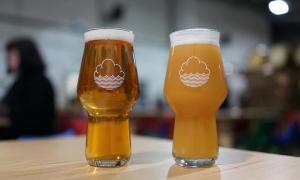
‘London Murky’, Mrs. T., and the politics of the haze craze
Keith Flett gets the round in again, tracing the political impact of Mrs. T on bright fined beer with his usal wit and clarity (geddit?).
It’s not often talked about but there is the issue of what Mrs Thatcher did to your glass of beer.
The ‘free choice’ capitalism where the market ruled, didn’t really do a great deal for the profitability of British industry, indeed it managed to destroy a fair bit of it. It did however open an era of choice in consumer goods, whether you wanted the choice or not.
You might think, for example, that what you want in a telephone, these days often a mobile, is one that works reliably, you can make calls on and access the internet and do so at a reasonable cost. In reality there are many, many phones to choose from, mostly not all that different from each other.
The same is true for beer.
Pre-Thatcher there were mainly regional brewers, with a few (by comparison with 2017, very few) smaller independents. They served a mainly tied pub estate. What they served in terms of beer were pints or half pints (definitely not thirds or two-thirds, though both are legal measures) of amber or brown beer.
That beer was, or should have been, fined and crystal clear. Whether it was in good condition - that is to say whether it tasted fresh and had some limited natural sparkle to it, and depending on whether you were north or south a big or a small foamy head - was another matter.
Very often, before the rise of the Campaign for Real Ale in the 1970s, cellar skills of landlords were not great, and nor was the condition of the beer. When I first started drinking around in the early 1970s - under age of course, quite possible in London then - a common drink was a ‘light and bitter’. That is to say, a half of cask ale and a bottle of brewery conditioned beer (not real ale) poured in to give the cask beer some life and often mask its less than great taste.
If you stuck with drinking pints from the handpump, clarity in your beer was important and the beer you drank was likely to be much the same in, week in, week out. Hence the expression you can hear in old films ‘a pint of the usual’.
The beer was of course ‘fined’ with fish bladders to ensure clarity. There are now alternatives, though many beers will still use this method unadvertised to those who may prefer not to ingest such things.
Hence the first thing you did when you got your pint was to look at it - and then sometimes sniff it - to check that it was clear. If it wasn’t it might well go back.
Of course there were barpersons across the country who would respond that since real ale was a living product, it was ‘meant to look like that’ and if there was also a twig sticking out of the murky liquid that just proved how natural it was. That last bit by the way, is, as far as I know apocryphal. I’ve never seen an actual pint with a twig in it.
It was the work of CAMRA to rescue living cask beer from old style, poorly served murk, and get across the point that the beer in the glass was meant to be clear.
Was it the case that if the beer was cloudy it tasted awful? Sometimes it was particularly if the haze was due to a yeast infection or some other off-note in the beer. But not always. Sometimes cloudy beer tasted fine, if not in the most desirable condition. Most who drank pints like that though knew that it was like consuming liquid All-Bran – with very similar results.
Then along came Mrs Thatcher and market choice. Guest beers were allowed in pubs owned by large breweries – this the work of CAMRA – and in due course another exponent of the free market, albeit in a rather different format to the Iron Lady appeared. Gordon Brown as Chancellor changed duty on beer to make it much easier for small brewers to set up and turn a profit.
And many did, hundreds and hundreds of them. Ten years ago in London there were less than ten breweries. Now there are over one hundred.
This expansion of breweries coincided (perhaps it was a bit more than coincidence, the jury is still out) with a vast expansion of the types and ranges of beers brewed.
Perhaps not entirely surprisingly, not all of these beers were clear in the glass and nor were they meant to be.
To underline how far the process has gone with what some might call London Murky, at the end of July I was in a well-known craft beer pub in central Hackney drinking a half pint of a 5.9% beer on key. It was in fact a keykeg beer- another way of serving real ale, not in a cask but in a plastic container where gas is used to force the beer to the pump but does not come into contact with the beer, so it is not ‘fizzy’.
The beer was crystal clear. All concerned were not happy. It used to be unfiltered and murky and everyone thought it had tasted much better when it was served like that.
At CAMRA beer festivals you will still see signs saying that a beer is not ready, often because it has not ‘dropped bright’ that is, it’s not clear. These days this is often more to do with it not being in the best condition and needing a little more time. You may also see signs warning that a beer is a little hazy - that is it tastes fine, but check where the nearest toilet is, and also signs pointing out that beer is meant to be cloudy.
This is the world of beer that Mrs Thatcher ushered in. Is it a step forward? Again I’d say the jury is still out on that one, but what a great time to be interested in sampling beer!


